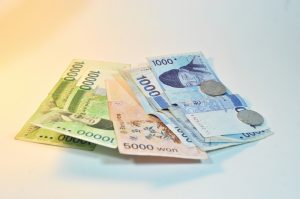Last week South Korea’s Ministry of Economy and Finance introduced a plan to legally limit the accumulation of public debt amid concerns that new spending could weaken the country’s financial standing. However, it is not clear how urgent this measure is, despite what boisterous domestic detractors would suggest.
In combatting the economic fallout of COVID-19 this year, the government has injected 277 trillion won ($241 billion or about 17 percent of GDP) into the economy through four supplementary budgets. The latest extra budget of 7.8 trillion won approved in late September brought total government debt to nearly 44 percent of GDP – around 5 percentage points higher than the start of the year. This tracks with the broader global trend of counter-cyclical government spending, but the recent upswing in South Korean public debt extends back before the pandemic.
South Korean President Moon Jae-in’s economic agenda has heavily leaned on government spending to drive growth. From the onset of his presidency in May 2017, Moon promised to create 810,000 new government jobs by the end of his five-year term and improve a thin social safety net. As government budgets have grown each year to hit Moon’s ambitious targets, so too has the country’s pool of debt. When Moon took office after the impeachment of conservative President Park Geun-hye, South Korean public debt was 32.3 percent of GDP. By the end of last year this figure had climbed to just shy of 40 percent. Even before the outbreak of COVID-19, the government had plans to spend more this year. The original 2020 budget Moon rolled out was 9.1 percent larger than the previous year to reinvigorate an economy that was projected to “only” grow at 2 percent.
Although international financial institutions, including the IMF, have agreed with the general direction of the Moon government’s spending priorities, conservative South Koreans have regularly framed the resulting debt in much more dire terms. The sense of alarm in these criticisms seems to have grown this year even as central bankers around the world are imploring governments for more fiscal stimulus. Responding to a larger government budget proposed for 2021, a September 4 editorial by The Korea Herald emphasized Moon’s actions as “a reckless spending spree” and called for a limit on the national debt-to-GDP ratio – which the government now plans to implement. A September 23 column by a Joongang llbo editor implored Moon to “order efficiency in fiscal management to contain our snowballing debt.” One of the most controversial parts of the government’s stimulus was a planned cell phone subsidy that was eventually scaled backed over widespread criticism from conservative groups and commentators who characterized the measure as “pure pork-barrel politics.”
The new measures proposed in early October were meant to signal that more spending would not mean profligacy. They would require the government to cap the debt-to-GDP ratio at 60 percent and the annual fiscal balance at -3 percent through 2025, with exceptions for crises. Though the plan still requires National Assembly approval, this is practically a forgone conclusion.
While conservative pushback against progressive spending has helped the government tightly adhere to fiscally responsible principles, there are also risks to not spending enough – especially in the short- to medium-term. Responding to the September 4 Korea Herald editorial in a letter to the editor, George Washington University International Business Professor and Board Member of the Korea Economic Institute of America Danny Leipziger largely brushed aside concerns about the government’s ability to service its projected debts. Instead, he implored South Korea to avoid “a tepid use of fiscal policy, such as was seen in the case of Japan, where demographics have doomed the resurgence of economic growth.” He added, “Excessive worrying about using counter-cyclical fiscal policy in current circumstances is to worry about the wrong thing.”
Although there is ample room to debate the specific policies, the Moon government has the fiscal space to address what it has rightly identified as key structural issues in the economy. South Korean public debt may have shot up during the Moon presidency, but it is still among the lowest in the OECD. Further, much of Moon’s agenda is directed at resolving stubborn economic challenges that will prove crucial to the future of the South Korean economy, such as inequality and stagnating productivity. It is certainly fair to criticize slow results in these areas, but that should necessitate more direct intervention, not less.
Part of the reasoning behind the cap on public debt is also to prevent a downgrade of South Korea’s credit rating, but it is not clear how much the current spending trajectory was risking this. In a report last week, Moody’s welcomed the proposal as a “prudent measure,” but added that even if South Korea were to hit its new debt ceiling “we expect that Korea will remain less indebted than advanced economies that share a similar rating, such as France and the UK.”
To be sure, South Korea does face significant long-term challenges, namely demographic decline, that will be a costly burden, but now is the time to ease or even reverse these trends. If done properly, current and projected spending could be seen not so much as taking on onerous debt but as making worthwhile investments.

































